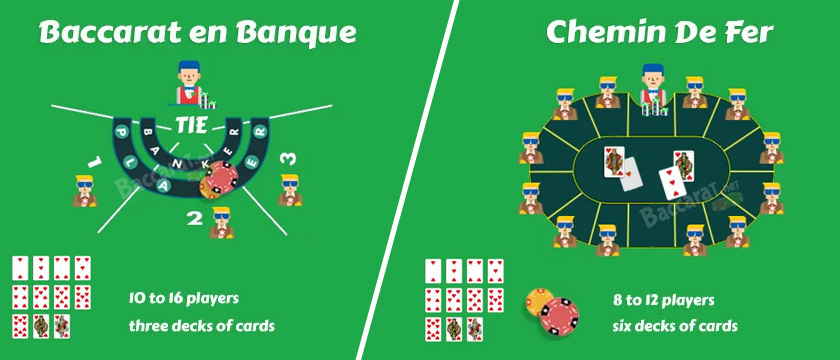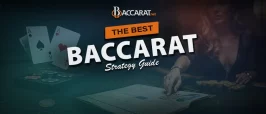Baccarat Banque and Chemin de Fer Compared

Baccarat has long been a favorite game of the gambling elite and as such, there has always been an air of mystery around it. Thanks to the rise of online gambling, all can now enjoy the game, regardless of the size of a player’s bankroll.
However, nearly every version of the online baccarat you can find is Punto Banco and there are in fact three main versions of the game. Here we will be looking at Baccarat Banque and Chemin de Fer, both of which remain popular in some of the world’s most exclusive casinos.
The Development of Baccarat
The history of Baccarat is fascinating. Originating in Italy during the middle ages, it later swept across France, where it evolved into several versions, including Baccarat Banque and Chemin de Fer.
Despite their differences, all Baccarat variations share core elements. The game aims to produce a hand total close to nine, with face cards and tens valued as zero and aces as one. The rest of the cards retain their face values. Players assume the roles of ‘banker’ or ‘player’, but these roles vary significantly in Baccarat Banque and Chemin de Fer.
The Basics of Baccarat Banque
Baccarat Banque stands out for its unique structure. In this game, one player takes on the role of the banker for an extended period, usually until they choose to leave the game, lose all of their funds, or until a previously agreed-upon number of rounds have passed.
Unlike other versions, the game starts with the banker staking an amount they wish to risk, with players then deciding whether to match this total stake and compete. This opens the floor for high-stakes gameplay, wherein the banker can either make significant winnings or incur substantial losses. Don’t forget to back off for a while after every big win or loss, the feeling of success can only come with pleasure in playing and having fun.
The layout of Baccarat Banque is also important. The game is played on a double table, capable of hosting up to ten players split between the two ‘tableaux’. The banker sits in the middle, with a croupier, or dealer, managing the game. Players can bet on either tableau, effectively creating two separate games happening simultaneously. Each tableau follows the same rules as traditional Baccarat, adding a layer of complexity to the game.
The Basics of Chemin de Fer
Chemin de Fer is characterised by its fast pace and high level of player interaction. Unlike Baccarat Banque, in Chemin de Fer the role of the banker rotates counter-clockwise among players at the end of each round. This rotation creates a more dynamic game and an air of unpredictability.
Players in Chemin de Fer face each other and the role of the banker is not fixed. After each round, the banker role moves to the next player on the right, giving everyone a chance to be the dealer and possibly control the game’s direction.
A unique aspect of Chemin de Fer is the negotiation phase. The banker stakes the amount they are willing to risk, and the other players, known as ‘punters’, decide whether to match this stake and ‘go bank’. This opportunity to challenge the bank creates a strategic element in the game, allowing players to influence the game flow.
Comparing Baccarat Banque and Chemin de Fer
While Baccarat Banque and Chemin de Fer are built upon similar principles, they offer very different experiences due to several subtle and not-so-subtle differences.
- The first and arguably the most noticeable difference is in the role of the banker. In Baccarat Banque, the banker’s position is consistent. A player who takes on the role remains the banker until they choose to leave the game or their bankroll is exhausted. This gives the game a slower, more strategic pace. There is also an element of high stakes risk and reward; the banker can win big or lose significantly based on their initial stake and subsequent decisions.
- Chemin de Fer, conversely, operates on a principle of constant change. The banker’s role rotates among players in a counter-clockwise direction with each round, leading to a more unpredictable and volatile game. This also tends to result in faster paced rounds as different players desire the chance to control the game.
- Another vital difference lies in the level of player interaction and decision-making. In Chemin de Fer, there is a negotiation phase that doesn’t exist in Baccarat Banque. Players can choose to ‘go bank’, matching the banker’s stake and taking them on directly. This aspect of negotiation and decision-making brings an added layer of strategy. It allows players to take calculated risks and attempt to influence the game’s course.
On the other hand, Baccarat Banque, with its predetermined rules and less flexible structure, is often considered a more straightforward game. There are fewer decisions to make, leading to a game that is more about chance and less about strategy. Players bet on either side of the table, effectively participating in two simultaneous games. This setup can create a fascinating dynamic, especially when the table is full, but it doesn’t offer the same head-to-head competition found in Chemin de Fer.
The pace of the games also differs significantly. Baccarat Banque, due to its structure and the permanence of the banker, tends to be a slower game. This pace allows for a more considered approach to betting and potentially more cautious gameplay. Conversely, the rapid rotation of the banker in Chemin de Fer accelerates the game, offering a more high-energy experience.
Lastly, it is important to look at the table setup and the number of decks used. Baccarat Banque is typically played on a double table with three decks of cards, while Chemin de Fer uses a single table and six decks. These factors can influence the gameplay, odds, and the overall experience.
Choosing between Baccarat Banque and Chemin de Fer
Ultimately, which you should play comes down to preference. If you enjoy a leisurely pace and less complex rules, Baccarat Banque is your best bet. Conversely, if you appreciate a quicker pace, unpredictability, and the opportunity to strategize, you might find Chemin de Fer more to your liking.
Regardless of which game you are drawn to, understanding the differences and the rules of each is essential. Both games offer unique challenges, can provide hours of fun, and some substantial winnings. While you are unlikely to find these games online, you now have all the information you need to take your seat at any Baccarat table the next time you are in a top land casino.



